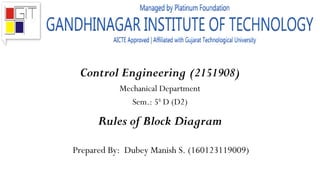
Rules of block diagram
- 1. Control Engineering (2151908) Mechanical Department Sem.: 5th D (D2) Rules of Block Diagram Prepared By: Dubey Manish S. (160123119009)
- 2. Rules for Block Diagram Reduction • Rule 1 : Associative law : •Now change the position of two summing points. Output remains same. •There is no intermediate block between two summing points or there is no take-off point in between the summing points. •Now interchange two summing points. •Now the output does not remain same.
- 3. • Rule 2 : For blocks in series : • The transfer functions of the blocks which are connected in series get multiplied with each other. • C(s) = R(s) [G1 G2 G3] • Output in both cases is same. • Rule 3 : For blocks in parallel : • The transfer function of the blocks which are connected in parallel get added algebraically. (considering the sign).
- 4. • Rule 4: Shifting a summing point behind the block : • C(s) = RG + y in the Figure. • Now we have to shift summing point behind the block, as shown in the Figure. • The output must remain the same, while shifting a summing point. • (R + x)G = C(s) RG + xG = RG + y xG = y • X= y/G so signal y must be multiplied with 1/G to keep output same. • Thus while shifting a summing point behind the block i.e. before the block, add a block having T.F. as reciprocal of the T.F. of the block before which summing point is to be shifted, in series with all the signals at that summing point.
- 5. • Rule 5 :Shifting a summing point beyond the block: • Consider the combination shown in figure • To shift summing point after the block keeping output same, consider the shifted summing point without any change. • RG +x = RG +yG • X= yG • i.e. signal y must get multiplied with T.F. of the block beyond which summing point is to be shifted. • Thus while shifting a summing point after a block, add a block after summing point is to be shifted, in series with all the signals at that summing point.
- 6. • Rule 6 : Shifting a take-off point behind the block. • Consider the combination as shown in figure • C = RG • Y = RG • To shift take-off point behind the block value of signal taking-off must remain same. • Shifting of take-off point without any changes does not affect output directly, the value of feedback signal which is changed affects the output indirectly which must be kept same. But without any change it is just R. • While shifting a take-off point behind the blocks, add a block having T.F. same as that of the block behind which take-off point is to be shifted, in series with all the signals taking-off from that take-off point.
- 7. • Rule 7: Shifting a take-off point beyond the block: • Consider the combination shown in figure • To shift take-off point beyond the block, value of ‘y’ must remain the same. To keep the value of ‘y’ constant it must be multiplied by ‘1/G’. • While shifting a take-off point beyond the block, add a block in series with all the signals which are taking-off from that point, having T.F. as reciprocal of the T.F. of the block beyond which take-off point is to be shifted.
- 8. • Rule 8: Removing minor feedback loop : • It includes the removal of internal simple forms of the loops by using standard result. • After eliminating such a minor loop if summing point carries only one signal input and signal output, it should be removed from the block diagram to avoid further confusion.
- 9. • Rule 9: for multiple input system use superposition theorem: • Consider only one input at a time treating all other as zero. • Consider R1, R2 = R3 = ……………Rn = 0 and find output C1, • Then consider R2, R1 = R3 = ………..Rn=0 and find output C2 • At the end when all inputs are covered, take algebraic sum of all the outputs. • Total output C = C1 + C2 +……..Cn • Same logic can be extended to find the outputs if system is multiple input multiple output type. Separate ratio of each output with each input is to be calculated, assuming all other inputs and outputs zero, then such components can be added to get resultant outputs of the system.
- 12. Block Diagram Example Example 1: H3 G1 H1 G3G2 H2 R(s) C(s) Minor Feedback Loop
- 15. Example 2: G1 G2 H2H1 G3 G4 C(s)R(s) Shifting take-off point after G2 G1 H2H1 G3 C(s)R(s) G2 Parallel Loop STEP-1